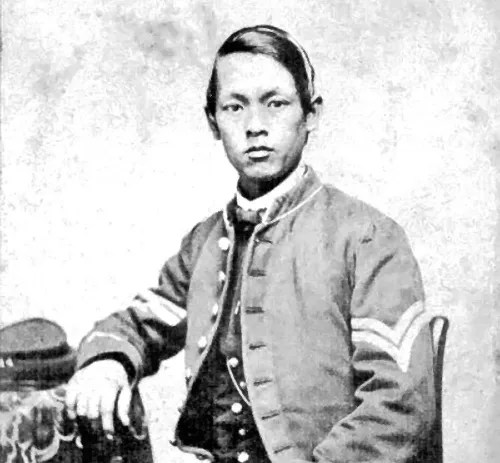Coogler’s “Sinners” peels back the veneer of Southern prosperity to expose the economic and racial underpinnings of a society built on exclusion and exploitation. Long before the Civil War, the South dominated the U.S. economy and cultural life through a slave-based system that generated vast fortunes for a select few. Into this world stepped the first Chinese immigrants in the 1820s — neither white nor Black, and thus difficult for the South’s racial hierarchy to categorize. Often recorded in censuses as “Mulatto” or racially mixed, Chinese Americans were perceived as occupying a murky in-between space: useful as laborers but denied full inclusion. Their ambiguous status reflects the South’s broader tendency to extract economic value from marginalized groups while denying them recognition or rights.
The center of U.S. culture in the mid-1800s was the South, not the North. Many parts of the North remained underdeveloped, akin to the “barbaric” streets of New York. The South dictated national norms, customs and immigration policies.
The Southern slave economy enabled a small elite of wealthy planters to amass extraordinary fortunes. The 1860 census shows the wealthiest 1% of Southerners held a median wealth more than three times higher than their Northern counterparts.
“Even counting slaves and estimating their income at subsistence, Easterlin’s estimates place Southern per capita income at 76 percent of the United States average in 1840 and 72 percent in 1860. Per capita income in the South was higher than in the North Central states — the Midwest of today — a good comparison since both of these sections were overwhelmingly agricultural in their economic life. Southern white per capita income exceeded the national average and compared favorably with that of the Northeast. The West South Central region exceeded the Northeast in per capita income in 1840, even considering the slaves as part of the population. For the free population alone, the North Central states had distinctly the lowest income-per-capita.” —Abbeville Institute
Chinese Americans were more prominent in the South than the North because wealthy white Southern oligarchs funded their migration for labor — akin to the mid-20th century Bracero program that brought Mexican workers to the U.S.
The idea of exploiting Chinese labor emerged in 1840s England. After securing colonies like Hong Kong, India and parts of Africa, British white supremacists devised pseudoscientific justifications for racial oppression. The socially and politically anti-federalist South, which had resisted the Revolutionary War, aligned closely with England’s ideologies.
Charles Darwin adopted eugenics from his cousin, Sir Francis Galton, a Victorian-era statistician who coined the term.
I still use Galton’s “Parable of the Ox Weight Contest” in political theory, but he was an appalling white supremacist.
In 1873, Galton wrote in the London Times that England should replace Africans in its colonies with Chinese settlers, arguing they were “smarter than Africans and easier to manage.” This ideology crossed the Atlantic.
By 1865, Southern newspapers editorialized for Chinese labor, inspired by claims it boosted Cuban agriculture. The goal was to position Chinese workers as a new exploitable class alongside African Americans.
At an 1869 Chinese Labor Convention in Memphis, Tennessee, Confederate General Nathan Bedford Forrest pledged $5,000 to import 1,000 Chinese workers. Recruitment began earlier, during the Gold Rush, but the Emancipation Proclamation intensified Southern urgency.
Planters sought to replace freed Black laborers with Chinese migrants from the Caribbean and China. Roughly 50,000 Chinese workers were already in the Caribbean, many fleeing the Opium Wars (1839-1860) and the Taiping Civil War (1850-1864). The latter, led by Hong Xiuquan — who believed himself Jesus Christ’s brother — ended with European powers extracting trade concessions and territory from China’s Qing dynasty.
U.S. immigration commissioner R.S. Chilton urged Congress to prohibit Chinese labor in the South, calling it “involuntary.” Southern advocates countered that Caribbean migrants arrived “voluntarily” after completing eight-year contracts. Many Chinese workers, however, were unaware their recruitment aimed to trap them in permanent second-class status.
Jefferson Davis, the Confederacy’s president, earlier served as a Mississippi senator, Mexican War hero and U.S. secretary of war (1853-1857). He sought to bind the West to Southern ports, commissioning railroad surveys from New Orleans and Memphis. To secure California’s ties to the South pre-railroad, he imported camels for Army trails in the Southwest.
Southern leaders nearly blocked the Transcontinental Railroad unless it originated in the South. Confederates deeply influenced California’s Gold Rush and railroad, prioritizing exploitable labor.
They embraced the “Mudsill” theory, articulated by enslaver and U.S. Sen. James Hammond of South Carolina, which claimed every society needs a racially subjugated labor class. “We work while the white man thinks,” he declared.
“In 1849, Charles Perkins, a white Mississippian, set out for California to mine gold with an enslaved man named Carter Perkins. They were soon joined by two other male slaves from the Perkins plantation, Robert Perkins and Sandy Jones, who had been forced to migrate West, leaving their wives and children behind. The three men went to work for Charles Perkins mining gold.”-Gold Chains
James Wilson Marshall, a New Jersey-born prospector with Confederate ties, enslaved Native Americans to mine gold after his 1848 California discovery. New Jersey, the last Northern state to ratify the 14th Amendment (January 1866), resisted abolition and Reconstruction.
“New Jersey was slow to abolish slavery and reluctant to pass the 13th Amendment, which it did in January 1866.”-Slavery in New Jersey
While Congress banned slavery in the Northwest, it permitted it in the Southwest (including California) under “popular sovereignty,” allowing local white majorities to decide. Enslaving Africans and Native Americans, or exploiting Chinese workers, was deemed acceptable if white residents approved.
The South’s plans to expand westward — including using Chinese labor — were disrupted by Reconstruction. Post-Reconstruction, Chinese migrants became “invited guests” in a region no longer controlled by Confederate elites.
Despite horrific violence, like the 1871 Los Angeles massacre that killed 19 Chinese Americans, the community thrived economically. By 1870, 63,000 Chinese Americans — 77% in California — contributed over $5 million via the Foreign Miners Tax, nearly a quarter of the state’s revenue.
Yet they faced relentless scapegoating from white workers competing with freed Black laborers.
The Chinese Exclusion Act of 1882 — the only U.S. law barring a specific group from immigration — reflected not just labor rivalry but anti-Asian white supremacy. Industrial oligarchs replaced plantation elites, but the racist foundation remained.
The Act epitomizes Northern complicity in racism. “Sinners” depicts America’s moral hypocrisy, rooted in a Southern oligarchy that accumulated wealth literally on the backs of the excluded.






